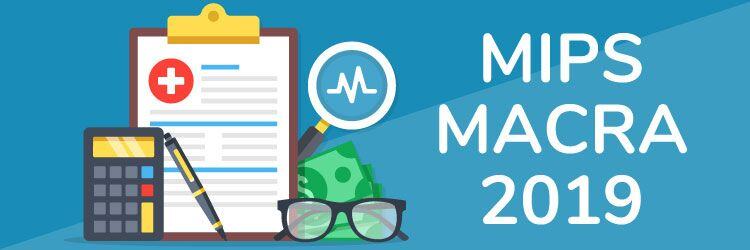What You Need To Know About MIPS MACRA 2019
Medical Billing / RCM | Electronic Health Records | Industry News | Healthcare Advice
We’re presenting here some easy-to-understand basics on MACRA for 2019. Many more exciting details can be found on www.cms.gov which should definitely be consulted if those details are needed.
MACRA’s 2019 final rules were released on November 1, 2018.
- You probably know that MACRA is the Medicare-related act (law) that contains among other things a segment called the Quality Payment Program (QPP).
- It’s the QPP - now in its third year - which covers the MIPS and APM methods of reporting data to Medicare in order to avoid the up to 7% penalties (“negative payment adjustments”) that can be assessed against 2021’s Medicare reimbursements for not having enough quality reporting in 2019, although CMS is predicting any penalties will probably be at least minimally under 7%.
- MIPS (the Merit-based Incentive Program) is for providers (“eligible clinicians”) and groups. For those who are not exempt from reporting, the 2019 threshold is being doubled, meaning ECs and groups need at least 30 MIPS points, up from 2018’s 15 points just to ensure avoiding the penalty.
To obtain an incentive (aka, “an exceptional performance bonus”), 75 MIPS points would need to be earned, up from 70 in 2018.
Who are MIPS-eligible ECs in 2019? In addition to those who’ve been eligible (MDs, DOs, DDSs, DDMs, DPMs, ODs, DCs, PAs, NPs, CNSs, CRNAs, and any clinician group that includes one of these), 2019 adds the following as ECs:
- physical, occupational, and qualified speech-language therapists
- qualified audiologists
- clinical psychologists
- registered dieticians or nutrition professionals
Exemptions: if you fall under any of the above classifications you’ll be required to report under MIPS to at least avoid the penalty unless you’re exempt. You need not report and you can’t be penalized if:
- you have $90,000 or less in Part B allowed charges for covered professional services
OR
- you provide care to 200 or fewer Medicare beneficiaries
Or
- this is a new one for 2019: you provide 200 or fewer covered professional services
under the Physician Fee Schedule (PFS)
Single MIPS Determination Period
There will be a single MIPS determination period for purposes of determining the low-volume threshold and to identify MIPS eligible clinicians as non-patient facing, a small practice, hospital-based, and ASC-based. The determination period includes 2 12-month segments:
An initial 12-month segment beginning on October 1, 2017 to September 30, 2018 (including a 30-day claims run out); and
A second 12-month segment beginning on October 1, 2018 to September 30, 2019 (does not include a 30-day claims run out).
Remember, if a TIN or TIN/NPI did not exist in the first time period, but does exist in the second, these eligible clinicians could become eligible for MIPS.
Performance Category Weights
The Quality and Cost categories will have different performance weights in 2019. The Quality category will drop from 50% to 45% of the Final MIPS score, while the Cost category will increase to 15%. The category weights for Promoting Interoperability (25%) and Improvement Activities (15%) will remain the same as this year.
The Quality reporting requirements remain mostly the same as 2018. Clinicians will still report 6 Quality measures, with at least 1 being an Outcome measure, or a High Priority measure if an Outcome measure is not applicable. Each measure will be reported on at least 60% of eligible cases for the entire year.
CMS is also adding 8 new Quality measures to report in 2019, while removing 26 measures it found were duplicative of other measures or extremely topped out. A list of these measures can be found here.
Small Practices
Small Practices (15 or fewer in the TIN) will continue to receive a small practice bonus, but it will be included in the Quality performance category score instead of as a stand alone bonus in 2019. The bonus is also increased to 6 points (up from 5 points in 2018) if the clinician submits data on at least 1 Quality measure. Small practices will also continue to receive at least 3 points for quality measures that do not meet the data completeness requirements.
Policy for Opting-In
Clinicians or groups would have the ability to opt-in to MIPS if they meet or exceed one or two, but not all, of the low-volume threshold criteria. Those clinicians who opt-in would be subject to neutral, negative or positive payment adjustments based on their MIPS performance and final score.
The Promoting Interoperability Category
CMS is overhauling the Promoting Interoperability (PI) category with several major changes:
PI remains a minimum 90 day reporting period, however, eligible clinicians would be required to use 2015 Edition of Certified Electronic Health Record Technology (CEHRT) if reporting this category.
Base, performance and bonus scores are eliminated and replaced with a new scoring methodology based solely on performance.
There are four objectives MIPS eligible clinicians must meet: e-Prescribing, Health Information Exchange, Provider to Patient Exchange, and Public Health and Clinical Data Exchange. Clinicians would be required to report certain measures from each of the four objectives, unless an exclusion is claimed.
The Security Risk Analysis measure will still be a required measure, but without points.
Two new measures are added for the e-Prescribing objective: Query of Prescription Drug Monitoring Program (PDMP) and Verify Opioid Treatment Agreement as optional with bonus points available.
CMS also maintains the hardship exemption for this performance category.
Multiple Submission Types
CMS would allow MIPS eligible clinicians and groups to submit quality measures via multiple submission types (new MIPS term for “submission mechanism”). If the same measure is submitted via multiple collection types, the one with the greatest number of points will be used for scoring. The multiple-submission type option would not apply to submissions using the CMS web-interface.
Large practices (16 or more in the TIN) will no longer be able to report via Medicare Part B claims.
As you’ve read, MIPS reporting now includes more EC types with increased penalties for those who are not exempt and who choose to either not report, or who fail to meet the new minimum 30 point threshold.
Your ECs might not obtain a bonus but you’ll at least want to ensure they avoid the up to 7% penalty against their 2021 Medicare reimbursements.
You should have a certified EHR (such as our Medics EHR) with its built in MACRA dashboard making it easy to track reporting progress, and a vendor (such as ADS) who has both collaborations with registries as well as its own in-house team of MACRA experts.
Besides MACRA, the Medics EHR is excellent for taking advantage of other lucrative CMS initiatives such as Chronic Care Management (CCM), Transitional Care Management (TCM), Patient Centered Medical Home (PCMH), and Comprehensive Primary Care Plus (CPC+) assuming you already have CPC initiative status.
Again, you’re encouraged to visit https://qpp.cms.gov for more overall information on QPP and for any additionally-needed details.
Simply fill out the form on this page for more information on the Medics EHR, how to possibly obtain incentives, but how to at least avoid penalties!
See why thousands of physicians and system users rely on automation from ADS.
Content pertaining to governmental information (e.g., CMS, Medicare, Medicaid, MACRA, etc.) is presented by ADS according to our best understanding of them. www.cms.gov or other reliable websites should be consulted, or the organization(s) should be contacted directly for details, or if clarifications are needed. ADS is not responsible for any typographical errors.
About Advanced Data Systems Corporation
Since 1977, clients have relied on the ADS team and our intelligent automation solutions and services. The MedicsCloud Suite, ADS’s latest generation of rules driven financial, revenue cycle, practice management, clinical charting and reporting, and mobility/engagement platforms, are used by clients to produce maximized revenue and efficiency for their practices, groups, and enterprise networks.
MedicsRCM (ADS RCM) is ideal if comprehensive outsourced revenue cycle management and billing services are preferred. MedicsRCM also uses the MedicsCloud Suite.






